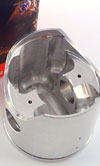Low-density, high-strength alloys
 In a previous article on aluminium-beryllium, we looked at how its combination of low density, stiffness and thermal conductivity makes it ideal for pistons. As I explained though, the material - for Formula One at least - is now prohibited, and outside Formula One, there is perhaps little appetite for using it.
In a previous article on aluminium-beryllium, we looked at how its combination of low density, stiffness and thermal conductivity makes it ideal for pistons. As I explained though, the material - for Formula One at least - is now prohibited, and outside Formula One, there is perhaps little appetite for using it.
Besides pistons, I mentioned a number of other applications where aluminium-beryllium might be considered, including static applications. In this article we will look briefly at some of the other materials used in reciprocating applications where aluminium-beryllium is now banned.
The most significant potential application of aluminium-beryllium, however, is definitely the piston, and in terms of low-mass alloys there are clearly a number which are currently widely applied. Aluminium alloys are the clear favourite here, and there are a few that are most commonly used for forged racing pistons.
There have been attempts to replace these over the years, yet for most people the old favourites remain the best choice. But there are a few significant developments in aluminium alloy technology that have been seriously considered for pistons and could be used for other reciprocating applications.
The first is a recently developed processing method that involves extremely rapid cooling from the molten state of specially developed alloys. The resulting material structure imbues them with great strength and significantly improved stiffness. The problem with these alloys in the past though has been a lack of ductility, but developments have improved this situation recently.
Lithium has lower density than aluminium and is used as an alloying element in a small but growing number of alloys, mainly for aerospace applications. In trials as piston alloys, however, they have produced with mixed results.
The combination of lower density and increased stiffness makes them an attractive prospect for pistons and other reciprocating parts. For instance, there are alloys that offer an improvement in modulus (a measure of stiffness) of 16% while being 10% less dense than a typical aluminium alloy. More commonly available Al-Li alloys offer a small density advantage (<5%) and an increase in stiffness of 5-10%.
Metal-matrix composites have been discussed in RET Monitor previously for pistons, and these materials are in the same position as aluminium-beryllium in that they are banned for Formula One applications. But they are used successfully outside Formula One for pistons and other applications, and there would therefore seem to be no logical reason to ban them from Formula One, which is often perceived to be the one series in motorsport which is a technical showcase.
Magnesium, again banned in Formula One, has been covered in RET-Monitor in an advanced metals feature. It has been used successfully for pistons in the past, and has been the subject of trials and testing relatively recently for more highly optimised machinery.
There are a number of good reasons why the material isn't used for pistons, but the lack of thermal conductivity and fact that it is so reactive are two that are of importance. Before being banned, however, it did find use in non-piston applications.
Fig. 1 - This two-stroke racing piston is make from a rapidly solidified aluminium alloy, giving exceptional strength (Courtesy of RSP Technology)
Written by Wayne Ward